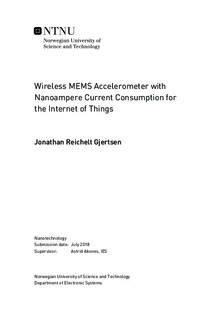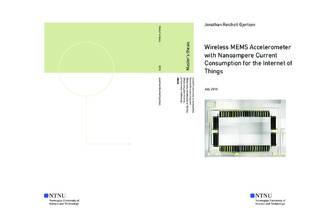| dc.description.abstract | Sensors are a key part of the Internet of Things (IoT). Accelerometers are particularly versatile, since knowledge about the motion of an object can be used for a large number of applications. Nearly all commercially available digital accelerometers use a microelectromechanical system (MEMS) as the sensing element, together with a readout circuit which typically requires a few microamperes. This thesis demonstrates that it is possible to perform acceleration sensing using a current consumption on the order of 50 nA by using a custom MEMS sensor that was designed and submitted for fabrication in a previous assignment. The readout circuit used for this purpose was invented at Disruptive Technologies AS for use in their ultra-low power wireless sensor nodes. The MEMS sensor is intended to extend the capabilities of these sensor nodes to include motion sensing.
Two versions of a bulk micromachined in-plane 1-axis accelerometer based on gap-changing comb capacitors were fabricated and characterized, and the results were compared to finite-element simulations performed in COMSOL Multiphysics. One of the versions has a higher spring constant than the other, but a smaller gap distance in the comb capacitors. Preliminary investigations indicated that this version had the best characteristics, and it was studied in further detail. The sensor's capacitance changes by more than fF/g for low accelerations. When interfaced with Disruptive Technologies' capacitance sensing circuit, the sensor output is linear up to 2g. For accelerations between 2g and 5g the output from the sensor is non-linear. The acceleration can still be calculated for these accelerations by using an equation that was derived from first principles, taking into account the non-linear effects of parasitic capacitance and nearest-neighbour fingers in the comb capacitor. For static accelerations, this equation is in agreement with the measurements to within the measurement error.
The frequency response curve is flat up to 200 Hz and the resonance frequency for in-plane vibration is 1 kHz. The sensor is most applicable in low-g applications with acceleration such as tilt sensors, and movement sensors which detect the presence or absence of motion.
The vibrational modes and high-frequency response for z-axis movement was characterized with the Optonor MEMSMap 510 optical measurement system. It was found that the simulations yielded correct eigenmodes, but overestimated the associated eigenfrequencies by 15% on average. | |

